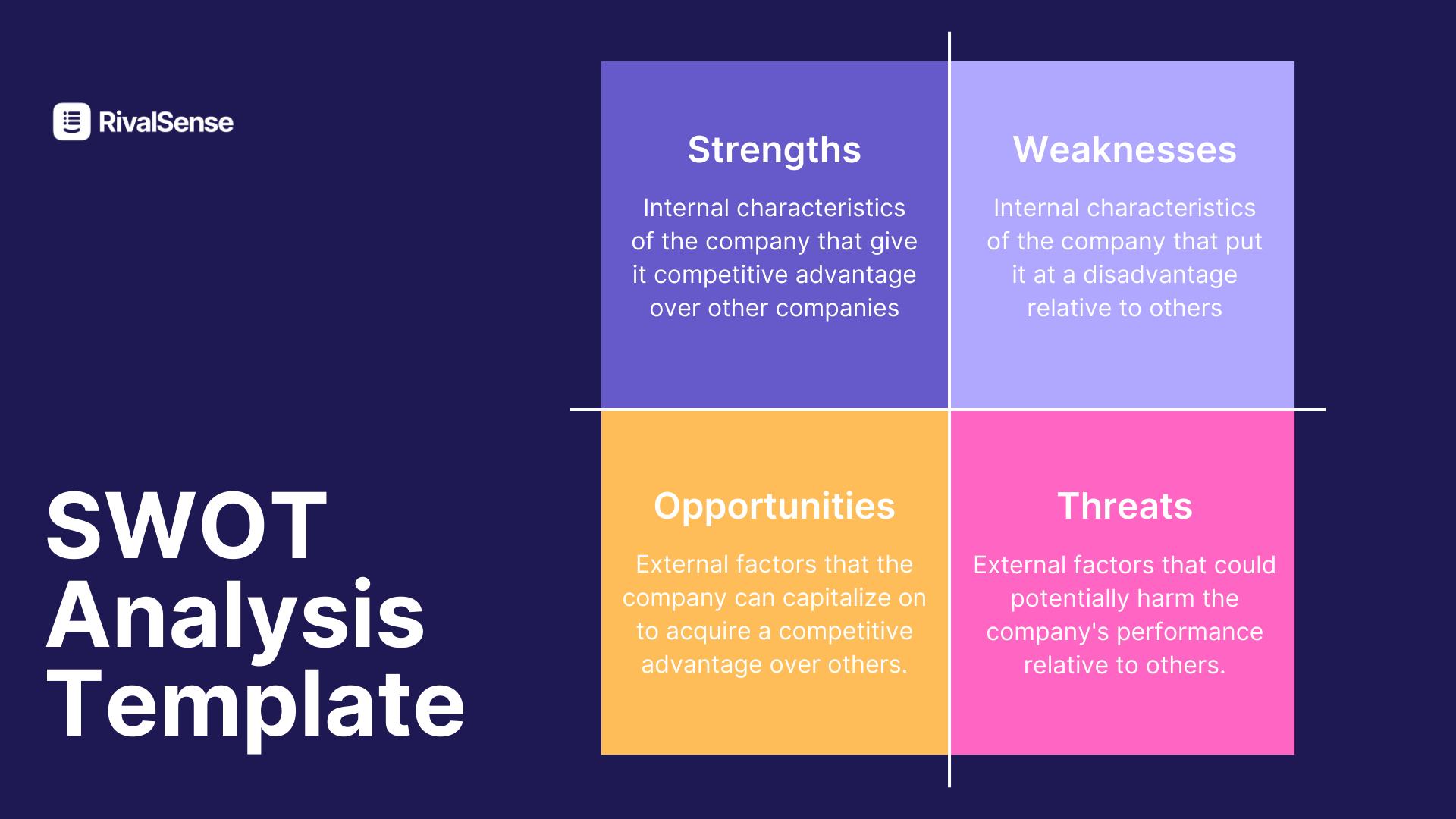Understanding the 4 Types of Competitors: A Guide to Effective Competitor Analysis
Your competitors can be categorized into four main types: direct, indirect, replacement, and potential competitors. You can identify these competitors using competitor monitoring tools and evaluate using SWOT analysis.

In today’s competitive landscape, understanding your competition is vital for staying relevant, meeting customer needs, and ultimately gaining a strategic advantage. In this article, we will explore the four types of competitors every business should know about: Direct Competitors, Indirect Competitors, Replacement Competitors, and Potential Competitors. Additionally, we’ll examine various methods to conduct a competitor analysis, such as using competitor intelligence reporting, conducting a SWOT analysis, and tracking company monitoring tactics to help you leverage actionable insights.
Your competitors can be categorized into four main types:
Direct Competitors: Companies offering similar products/services in the same market.
Indirect Competitors: Businesses providing different products that satisfy similar customer needs.
Replacement Competitors: Alternatives that can replace your offering in the minds of consumers.
Potential Competitors: Emerging businesses or market entrants that may pose future threats.
Each type has its role and impact, and sometimes, strategic partnerships with non-direct competitors can even benefit your business. In this guide, we’ll look at identifying these competitors, running a SWOT analysis, and conducting competitor monitoring using various intelligence tools and approaches.
When you came up with your latest business idea, you probably envisioned it as a game-changer, poised to disrupt the industry. And hey, it very well might be! But here’s the reality check: no product is created in a vacuum. Other businesses are likely aiming for similar markets, and some may even be offering comparable solutions. Understanding the competitive landscape isn’t just important; it’s essential for surviving and thriving in any market.
In this article, we’ll break down the four types of competitors you’ll encounter: Direct, Indirect, Replacement, and Potential Competitors. We’ll explore how each affects your market position, offer strategies to identify them, and dive into competitor monitoring methods, including competitive intelligence tools. Let’s get started on turning competitive insights into your strategic advantage!
The Benefits of Monitoring Competitors
Tracking competitors isn’t about copying their every move; it’s about understanding what they’re doing well (or not) to sharpen your edge. Competitor insights help you:
- Spot market trends early: Recognize and respond to shifts in demand or new regulations.
- Identify strengths and weaknesses: Address gaps where your competitors may fall short.
- Enhance product offerings: Develop solutions that outshine similar products.
- Set strategic pricing: Gauge pricing models to offer competitive value.
- Align with customer expectations: Improve based on feedback about competitor products.
- Counteract their strategies: Stay a step ahead with proactive marketing and innovation.
- Prepare for fundraising: Deep insights into competitors can improve your fundraising pitch significantly

What Are The 4 Types of Competitors in Marketing?
Understanding competitor types allows for a more strategic analysis. Here’s a breakdown of the four competitor types you’ll likely encounter, complete with real-world examples and actionable insights.

1. Direct Competitors
Direct competitors sell the same or similar products or services to the same target audience. They’re after the exact customers you are, often with comparable products and solutions.
Example: Uber and Lyft are direct competitors, as both offer rideshare services targeting urban and suburban consumers who prefer alternative transportation options.
Why Track Them? Direct competitors are your closest rivals. Monitoring them is essential to understand industry standards, pricing strategies, and customer needs. They push you to innovate, improve, and differentiate your offerings.
How to Monitor Direct Competitors:
- SWOT Analysis: Examine their strengths and weaknesses.
- Customer Feedback: Track reviews on platforms like Yelp or Google to understand customer sentiments.
- Market Positioning: Compare product features, benefits, and pricing to find differentiation points.
- Tools Directories: Sometimes tool directories allow you to set alerts for when a similar company (industry, geography, keywords) is added to a list, allowing you to notice them early
2. Indirect Competitors
Indirect competitors fulfill the same customer needs with different products or services. They may be in different industries, but their offerings appeal to the same market.
Example: A gym and a home fitness app like Peloton are indirect competitors; both help people stay fit but in different ways.
Why Track Them? Indirect competitors reveal insights about customer preferences and emerging trends that may reshape expectations for your offerings. They help you understand your market better and anticipate shifts that could influence consumer choice.
How to Monitor Indirect Competitors:
- Consumer Trends: Use social listening tools to see how customers talk about different solutions.
- Industry Reports: Analyze trends in related industries to anticipate indirect competitor moves.
- SWOT Analysis: Identify strengths and weaknesses to inform potential product expansions.
3. Replacement (or Substitute) Competitors
Replacement competitors are alternative solutions that customers could use in place of your product or service. They satisfy similar needs but may not directly compete with your current offerings.
Example: For a local coffee shop, home coffee machines or instant coffee brands are replacement competitors, providing an alternative way for customers to satisfy their caffeine fix.
Why Track Them? Replacement competitors can shake up market dynamics by giving customers a new way to fulfill their needs. This type of competition can encourage you to innovate, diversify, and retain relevance.
How to Monitor Replacement Competitors:
- Product Lifecycle: Track where your product sits in its lifecycle and monitor emerging substitutes.
- Market Surveys: Survey customers periodically to gauge their openness to alternatives.
- Competitor Intelligence Tools: Use tools like SEMrush to analyze trends and identify keywords for substitute products.
4. Potential Competitors
Potential competitors are businesses that don’t currently compete with you directly but have the capability to enter your market or expand their offerings in a way that overlaps with yours.
Example: For traditional banks, FinTech startups offering online loans or financial management tools could be potential competitors.
Why Track Them? Potential competitors help you prepare for industry disruptions. Recognizing new entrants and their possible impacts keeps you prepared and adaptable.
How to Monitor Potential Competitors:
- Industry News: Track news to identify emerging startups or evolving business models.
- Investor Activity: Monitor funding trends through platforms like Crunchbase to see where new investments are flowing.
- Patent Tracking: Check patent filings to identify emerging innovations that could enter your market.
How to Identify and Track Competitors: Quick-Start Techniques
Competitive analysis can be time-consuming, but these steps and tools make it manageable:
1. Understand Consumer Preferences
Dive into your target audience’s needs and preferences to understand how competitors fit into their decision-making process. Gather insights through market research, surveys, and social media data to pinpoint areas where you can excel or differentiate.
2. Conduct a SWOT Analysis
A SWOT analysis (Strengths, Weaknesses, Opportunities, and Threats) offers a clear picture of your position versus competitors.
- Strengths: Evaluate advantages that set you apart.
- Weaknesses: Recognize areas for improvement.
- Opportunities: Identify gaps in the market.
- Threats: Spot external factors that could impact your business.

3. Track Competitor Activities Regularly
Use tools and methods to track various competitor activities and adjust your strategy accordingly. Here are some efficient methods:
- Google Search: Start with a simple search for competitor names to view recent mentions and discover targeted keywords.
- Website Analysis: Examine competitor websites for content, SEO tactics, and user experience.
- Social Media Monitoring: Use social listening tools like Hootsuite to track competitors’ engagement and promotional strategies.
- Email Marketing: Sign up for competitor newsletters to keep tabs on promotional and product updates.
- SEO and Content Tracking: Tools like Ahrefs reveal SEO insights, including keyword usage and ranking shifts.
- Customer Reviews: Scan reviews on sites like Trustpilot or Yelp to see what customers appreciate or dislike about competitor offerings.
- Competitive Intelligence Tools: Solutions like RivalSense provide curated insights on fundraising, market entry, product launches, and other news.
Competitor Analysis FAQs
Q1: What types of competitors should a business track? Businesses should monitor direct, indirect, replacement, and potential competitors to cover all bases and stay ahead of potential market shifts.
Q2: Why is tracking competitors essential for success? Competitor tracking reveals customer trends, market opportunities, and potential threats. It also encourages innovation, helping businesses adapt to customer needs and stay relevant.
Q3: What’s the most efficient way to conduct competitor analysis? Leverage competitor intelligence tools for faster, data-driven insights. For example, SEMrush and Ahrefs excel in SEO tracking, while Crunchbase is useful for monitoring potential competitors.
Q4: How often should I update my competitor analysis? Monthly or quarterly updates are ideal for maintaining a clear view of your competitive landscape, with more frequent tracking in rapidly evolving markets.
Q5: How many competitors should I track? Start with 3-5 primary competitors (both direct and indirect) to gain a well-rounded perspective, then expand based on available resources.
Q6: Can competitors actually help my business? Yes! Competitors can provide valuable insights and even partnerships. By analyzing competitors’ weaknesses, you may find market gaps to fill or potential alliances that could benefit both parties.
Competitor analysis can be time-consuming, but the insights are worth it. Consider using tools that automate the process, like RivalSense, which tracks competitor website pages, SEO, and email marketing. Start gaining a competitive edge today!

